Content
- 1 What is the cause of potato diseases
- 2 What are the symptoms to determine that the potato is sick
- 3 The main types of potato disease
- 4 The manifestation of bacterial diseases on tubers, and methods of combating them
- 5 Manifestation of viral diseases, and methods of dealing with them
- 6 Manifestation of fungal diseases, and methods of dealing with them
- 7 Conclusion
There are various potato tuber diseases, most of which even an experienced gardener cannot identify at the initial stage. From this, the disease begins to spread to other healthy bushes, destroying the entire crop. Many drugs have been invented for the treatment of most potato diseases. However, in order for them to work effectively, it is necessary to determine exactly what the culture should be treated for. In this article, we have collected the most common potato diseases, and each of them is accompanied by instructions for dealing with the disease.
What is the cause of potato diseases
Most gardeners believe that potato tuber diseases are to blame pests and weather conditions. They are partly right. However, there is another side of the problem that a person rarely admits - this is the fault of the vegetable grower himself.
There are three main causes of potato disease, in the occurrence of which it is not pests that are to blame, but the person himself:
- incorrect selection of tubers for planting;
- violation of crop rotation technology;
- improper care of potato plantations.
Now let's take a quick look at each of the problems. What is the wrong selection of planting tubers? It is clear that the affected potatoes cannot be left for planting. But you also need to choose the right varieties. There are many breeding potatoes on sale now. That is, hybrids. They are immune to most diseases. There are even potatoes whose leaves are not eaten by pests, such as the Colorado potato beetle. But each hybrid is bred for specific growing conditions. If you plant tubers that are not intended for the climatic conditions of the region or the soil does not suit them, the immunity endowed with breeders disappears, and the potatoes begin to hurt.
When growing potatoes, it is imperative to observe the crop rotation. This is where pests will play a bad role. They remain in the ground after autumn harvesting, hibernate, and wake up in spring and begin to infect young tubers. Some of them are capable of destroying ripening potatoes.
Often potato plantations are ruined by improper care. We missed watering - the culture was depleted in the heat, overdid it with irrigation - phytophthora went. Also, leaving implies timely weeding. weeds, loosening the soil, etching the Colorado potato beetle and other activities.
What are the symptoms to determine that the potato is sick
The initial stage of crop diseases is difficult to determine even for an experienced gardener. But if you conduct careful observations of the state of the plant, then you can identify the disease even when the potatoes can be saved. Let's say late blight manifests itself not only on tubers, but also affects the aerial part of the plant. If the leaves and stems have begun to turn black, action must be taken immediately.
The infestation of potatoes can be recognized by the appearance of aphids. These pests are carriers of diseases.This problem can be avoided with timely weeding and dressing of plantings with special preparations.
The main symptom of potato tuber disease is the condition of its tops. A culture affected by any disease begins to lag behind in growth, the color and shape of the leaves changes, the plant begins to wilt. At this stage, you need to dig out one such bush, and try to determine the cause of the disease by the tubers in order to choose the right drug for treatment.
The main types of potato disease
The photo shows a table with examples of common potato ailments. But there are a lot of diseases, so they are conventionally divided into three types:
- All types of bacterial diseases are transmitted through planting material, that is, tubers. Moreover, the pathogens winter comfortably in the ground. Even if healthy tubers are planted in an infected garden, they will still be affected. Putrefactive bacteria do not die in the heat and even in winter with severe frosts.
- Viral diseases include all types of mosaics. The disease changes the color and shape of the aerial part of the plant. The culture may not even die, but very few tubers will be tied.
- The fungus damages any part of the culture. The most common ailment in this series is late blight. It quickly spreads over all plantings. If you do not take action in time, all the potatoes can be lost. Fungus for potatoes is doubly dangerous. In addition to the fact that it infects the culture itself, it additionally kills its immunity to resistance to other diseases.
For any type of disease, there are individual control measures. Now we will consider a photo description and treatment of diseases of potato tubers, and we hope that our information will help many gardeners to save their harvest.
The video tells about the ailments of potatoes, and methods of dealing with common diseases:
The manifestation of bacterial diseases on tubers, and methods of combating them
With a bacterial disease, potato tubers are affected in the soil, and pathogens are also spread along with poor planting material. The crop begins to rot and becomes completely unfit for human consumption.
Ring rot of tubers
This type of rot most often destroys tubers. The disease begins to manifest itself on the tops. at first wither leaves, after which the stems fall to the ground. If you cut the affected tuber, then rot can be seen around its circumference. Hence the name of the disease came from. The causative agent of rot lives for a long time mowed tops, so it is better to burn it right away.
There is one secret of how to accurately diagnose. To do this, break off one stem from a withering bush, and put it in a glass of water. After a while, mucus begins to stand out from it. You can dig up the tubers. When cut, not even a rotten, but affected potato, a yellow formation in the form of a soft ring is visible on the cut.
It is necessary to fight rot at the stage of preparation of planting material. It is not advisable to cut large potatoes into several pieces. If the tubers are very large, they are cut with a disinfected knife, and the cut site is treated with wood ash. Potatoes bought for divorce are thoroughly washed, and then dried at a temperature of 17aboutWith a minimum of 10 days.
You can prevent the occurrence of rot in the garden by mowing the tops shortly before the start of harvesting. If the disease has already struck the culture, the bush must be immediately dug up, after which it is advisable to burn it.
The defeat of tubers with brown rot
This type of rot destroys only tubers. However, the symptom can be identified by the withering aerial part. The affected bush is greatly stunted in growth, and the stems begin to fade.
Affected potatoes can be seen in the garden during flowering. The stems become lethargic, which is why the bush begins to droop and fall apart on the sides. The leaves turn yellow, wrinkle, and dry out over time. There are no methods of dealing with the disease. There are only measures to prevent the onset of the disease. You just need to buy high-quality planting material, as well as observe crop rotation. In general, it is better to start varieties that are resistant to brown rot.
Mixed internal tuber rot
This disease occurs on mechanically damaged potatoes. As long as the tubers lie in the ground untouched, you don't have to worry about this ailment. When digging up the crop or careless transportation, many potatoes undergo mechanical damage, through which putrefactive bacteria penetrate. The tubers begin to slowly rot from the inside during storage in the cellar.
The method of dealing with internal rot can only be a thorough sorting of potatoes, before laying the crop for winter storage. The cellar and bins must be treated annually with a solution of copper sulfate.
Wet rot of tubers
The causative agent of wet rot penetrates into the potato tissue through the same mechanical damage. Tissue damage occurs during harvest, but the result is not immediately visible. Potatoes begin to rot in the cellar. Moreover, the disease spreads to other nearby tubers, even if there is no mechanical damage to them.
Wet rot can be recognized by feeling the tubers. Potatoes become unnaturally soft. When pressed with fingers, light starchy mucus is released from under the peel. The process is accompanied by an unpleasant odor.
You can avoid the manifestation of the disease if you store the harvested crop in a disinfected basement with good ventilation and dry air. Before entering the cellar, edible potatoes are sorted, discarding damaged tubers. The planting material is treated with disinfectants before storage.
Blackleg
This ailment often suffers from potatoes planted in the place where cabbage grew last year. In the affected culture, the stems near the ground begin to turn black and gradually turn into rot. The tubers begin to become covered with a wet bloom, after which they also disappear.
The first appearance of a black leg can be identified by the yellowness and lethargy of the leaves on the bottom of the plant. One has only to grasp the thin stem, it will easily be pulled out of the ground. The tissue of the potato itself acquires a soft texture that gives off an unpleasant odor.
The manifestation of this disease can be avoided by careful selection of planting potatoes, plus compliance with crop rotation. In the fall, all dry vegetation must be removed from the garden.
Manifestation of viral diseases, and methods of dealing with them
There are several types of mosaics. Any manifestation of it on potatoes is defined as a viral disease.
Speckled or common mosaic
The disease manifests itself as yellow spots on the leaves of young potatoes. However, exactly the same signs are observed on a plant with a lack of iron in the soil. For a more accurate diagnosis, it is necessary to observe diseased bushes. If the yellow spots gradually take on a brownish tint, the plant is 100% infected. The potato bush must only be completely removed, and it must be immediately thrown into the fire. All neighboring unaffected plants are treated with antiviral drugs.
Striped mosaic
This disease has several strains. Depending on the pathogen, the symptoms will be different. Although there are common features that make it possible to identify the virus. First, the fragility of the plant increases.The stem breaks from light pressure with the hand. Secondly, stripes and dots of different colors appear throughout the plant. The back of the leaves becomes brown.
The virus spreads instantly, leaving no chance of survival for neighboring potato bushes. The affected plant should only be removed from the garden and burned in a fire.
Wrinkled mosaic
By the name of this virus, it can already be determined that the leaves of the potato are beginning to wrinkle. In some areas, yellow spots appear. The result of the epidemic is a large loss of crops.
The wrinkled mosaic virus progresses only in hot dry summers. This does not happen every year, and only when weather conditions are favorable for the pathogen.
Rustling mosaic
This type of virus is also called leaf curl. Infected potatoes cannot be identified immediately. Symptoms are observed in the second and third years of growing the same variety. Every year, potato bushes become shorter in growth. In the third year, the leaves of diseased plants are twisted into a tube from the edges to the central vein. Over time, they acquire a bronze tint and become brittle. If you run your hand over such foliage, it will partially begin to crumble, making a rustling sound. Simultaneously with the aboveground part, the root system is affected. This leads to the formation of a small tuber ovary or none at all.
Since it is almost impossible to detect the virus at an early stage at home, it is better to start another potato variety from healthy planting material next year.
Manifestation of fungal diseases, and methods of dealing with them
The fungus quickly infects tubers and the aerial part of potatoes, penetrates into neighboring plants through mechanical damage, and instantly spreads throughout all plantings. The harvest can only be saved by timely detection of the disease and the rapid adoption of appropriate measures.
Late blight
Late blight spreads instantly over the potato field. If you show no action in the fight against this fungus, all healthy bushes will disappear in a couple of weeks. The first sign of a fungus is brown spots on the potato leaves, gradually growing over the edges with a white bloom. The disease spreads from leaves to stems and tubers. Its further manifestation depends on the weather. If it's hot outside, the aboveground part of the potato simply dries up. In a wet rainy summer, the tops affected by late blight simply rot.
The carrier of phytophthora is water. It doesn't matter if it is rain or artificial irrigation, but together with water droplets, fungal spores are spread, which settle on the stems of healthy plants.
There are several preventive measures to help avoid late blight. First, the planting material must be germinated and processed before planting. After germination, the grown potato bushes are piled up with high mounds. Secondly, you cannot grow potatoes every year in the same place. In addition, tomatoes are not the best neighbor in the garden.
For the prevention of late blight, copper sulfate is used. When potato bushes grow up to 20 cm in height, they are sprayed with a solution prepared from 10 liters of water and 10 g of blue powder. If the disease has already been noticed on the plants, then a 1% solution of Bordeaux liquid is used to treat potato plantations. For one hundred square meters of the garden, 4 liters of solution are consumed. Spraying is carried out 4 times with an interval of a week between each procedure.
The video tells about protection against late blight:
Common scab
Spores of this fungus persist for a long time on cut potato tops and other vegetation. The disease most often affects potato varieties that bring tubers with red thin skin. Cork-like cracking spots appear on the surface of the potato. Such damage to the shell opens the way for other pathogens of the disease that cause rot to enter the pulp.In practice, it was found that the disease most often develops in areas with sandy or limestone soil.
Confront common scab preventive measures help. The planting material is germinated before planting in the light so that the skin of the tubers acquires a greenish tint, but even before that, formalin treatment is performed. Good results are obtained by sowing siderates and observing crop rotation. It is better to plant varieties that are resistant to scab damage. If you still want to grow your favorite variety of red potatoes, then for planting you need to choose a site with slightly acidic soil, and plant the tubers themselves shallow.
Silver scab
The manifestation of the disease on potato tubers can be recognized by brown spots with a silvery edge. During storage in a damp cellar, the skin of the affected potatoes partially peels off.
The peak of development of the silvery scab is the period of tuber ovary in hot weather. Moreover, most often this occurs in areas with sandy loam or loamy soils. In autumn, during the selection of planting material, care must be taken to ensure that the affected tubers do not fall for planting.
To combat the disease, drugs are used with Fundazol or Botran, which are used to treat the tubers before planting. After harvesting, the potatoes are dried for about three days, and only then are they lowered into the cellar. The storage is annually treated with preventive solutions.
Powdery scab
The disease affects the bottom of the potato stems, the root system and the tubers themselves. The disease progresses in rainy summers and can be identified by white formations on plant stems. To be sure, you need to dig out one infected bush. The roots of such potatoes will also have a white build-up. Over time, the white formations turn into dark, cracking specks. Spores of powdery scab retain their vital activity in soil, tubers and even manure.
The measures to combat the disease are practically the same as for any other type of scab. The main thing is not to throw away the affected potato tubers for rotting in compost heaps. The fungus in the manure does not die, and when top dressing is applied, it again spreads through the garden.
Cancer diseases
This disease has a limited spread, but it is very dangerous because the pathogen remains in the ground for a long time. Most often, the disease is found in private small gardens, where potatoes are grown for years in the same place. Moreover, potato varieties susceptible to cancer are affected.
The first signs of the onset of the disease are the appearance of growths on the lower part of the plant. Leaves, stems and tubers of potatoes are the target of damage. Over time, the growths begin to darken, and, reaching black, open during decay. Many mature spores enter the ground from cancers, where they continue their vital activity.
In the ground, disputes persist for more than twenty years. Together with the soil, they stick to healthy tubers, are carried to neighboring areas by melt water, the feet of domestic animals, birds, and so on.
It is possible to stop the spread of the disease by growing potato varieties that are resistant to cancer. Moreover, it cannot be planted next year where there was an epidemic focus. It is better if other crops, such as beets, beans or sunflowers, will grow on this site within five years. Before planting them, lime is introduced into the soil, but in reasonable quantities. Otherwise, when growing potatoes in the future, there will be a problem with scab. If the size of the garden allows, then dangerous areas can be left under pairs.
Dry rot of tubers
This fungal disease does not show up on growing potatoes. Dry rot forms on tubers stored in a cellar. This process usually begins two months after harvesting.Spores of the fungus persist in the ground for up to six years. Together with the soil, they stick to the potato tubers, after which they enter the cellar. The vital activity of pathogens continues on the walls of the storehouse, if it is not disinfected before laying the crop.
Potato tubers become infected with dry rot only through mechanical damage to the skin. It doesn't matter if it is in the field or in the cellar. Spores can be carried by rodent pests. First, gray spots appear on the skin of the potato, acquiring a brown tint over time. The pulp under the affected areas begins to rot and dry out. The potato becomes shriveled, hard and very light. White growths appear on the rotten skin. It is in them that new spores of the fungus are formed, which, after ripening, infect healthy potato tubers. The optimal conditions for the development of fungus in the cellar are a high humidity concentration of about 90% and an air temperature above 5 ° C.
In the fight against this ailment, all measures used to combat other diseases are justified. You also need to try to inflict as little mechanical damage as possible on the tubers. An important measure is the disinfection of the storage where the potato tubers will winter. Before laying the harvest, the cellar is treated with a solution consisting of 10 liters of water, 100 g of copper sulfate and 2 kg of lime. Secondary disinfection is carried out with a fungicidal stick. From folk methods, good results are obtained by burning dry stems of wormwood in the cellar. During the laying of potatoes, dry leaves of mountain ash, elderberry or onion husks are scattered between the tubers in the bin.
Conclusion
Most common potato diseases can be avoided if the plantings are treated with pest drugs in a timely manner, crop rotation and preventive measures are observed. When breeding new varieties of potatoes, planting material should be purchased only from trusted firms.
The video presented will help the grower learn how to process potato tubers before planting:
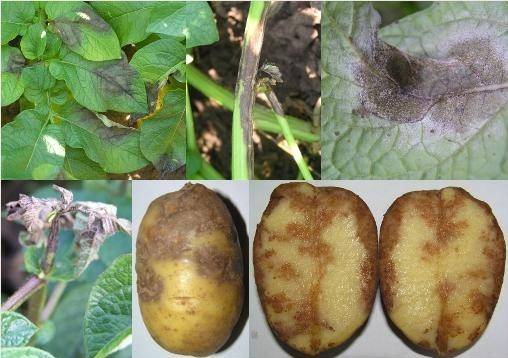
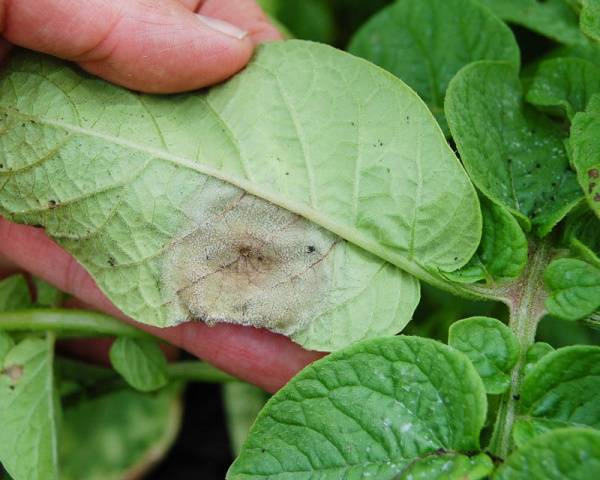

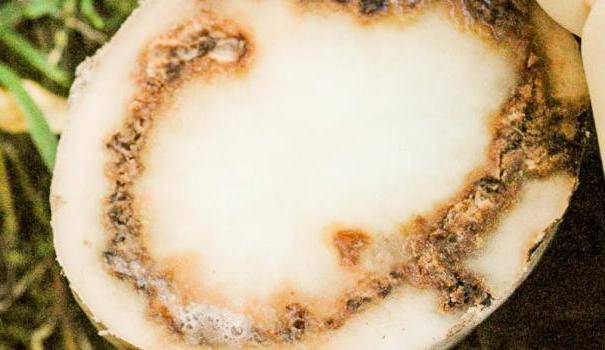

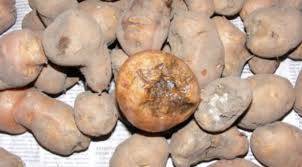
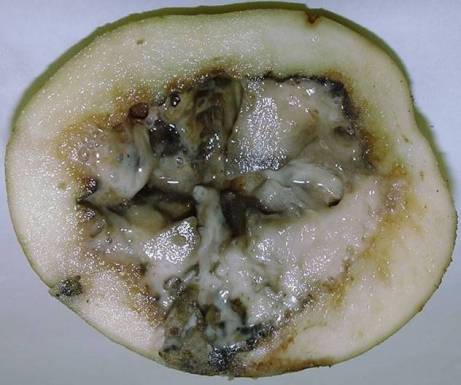

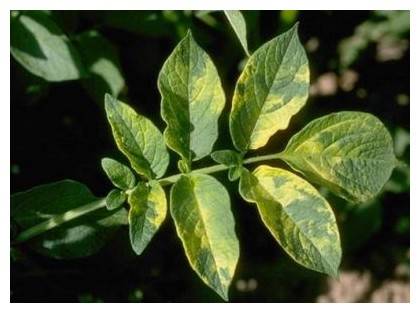



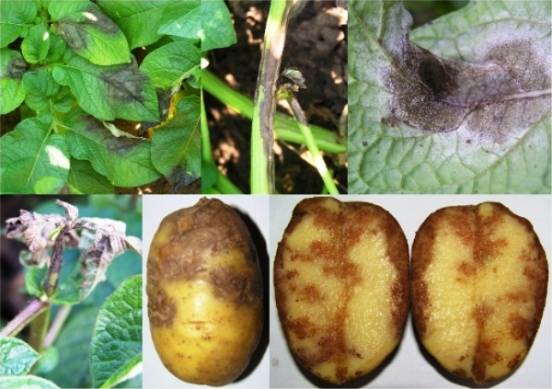
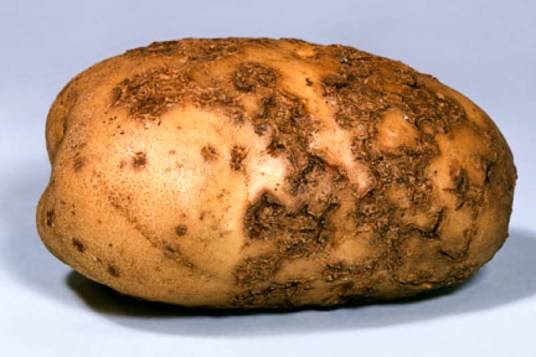
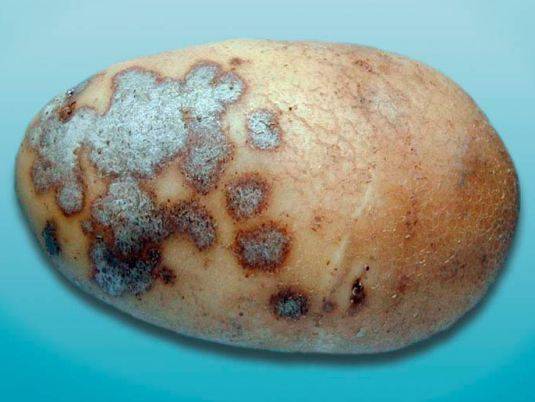












Why are potato tubers deformed
Good day!
There may be several reasons why potato tubers grow clumsy:
• Abrupt change in weather conditions. Most often, the deformation of tubers is observed in cases when sunny and fine days are replaced by long, lingering rains.
• Diseases. Among them it is worth noting: button rot (fomoz), black leg and scab. Infected potato tubers not only deform, but also crack and rot from the inside.
• Soil of poor composition, as well as soil with increased acidity, clay soil and loam. Despite the widespread belief that potatoes are an unpretentious crop, for a good harvest, you still need to create good conditions for it to grow. First of all, it is necessary to normalize and enrich the soil with microelements. The soil should be loose and fertile.
• Violation of the watering schedule. In many regions, gardeners grow potatoes on large areas and do not use artificial irrigation. In this case, the reason for the deformation of the tubers is described above (weather conditions). If you are watering potatoes by hand, you need to keep the regularity and volume of water.
What factor caused the curvature of potato tubers, you have to find out and, if possible, eliminate.